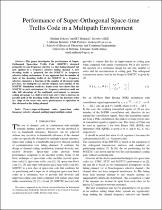 ResearchSpace
ResearchSpace
Performance of super-orthogonal space-time trellis code in a multipath environment
JavaScript is disabled for your browser. Some features of this site may not work without it.
- ResearchSpace
- →
- Research Publications/Outputs
- →
- Journal Articles
- →
- View Item
| dc.contributor.author |
Sokoya, OA

|
|
| dc.contributor.author |
Maharaj, BT

|
|
| dc.date.accessioned | 2008-12-04T13:56:24Z | |
| dc.date.available | 2008-12-04T13:56:24Z | |
| dc.date.issued | 2007-09 | |
| dc.identifier.citation | Sokoya, OA and Maharaj, BT. 2007. Performance of super-orthogonal space-time trellis code in a multipath environment. IEEE Africon, Windhoek, Namibia, 26-28 September 2007, pp 5. | en |
| dc.identifier.uri | http://hdl.handle.net/10204/2658 | |
| dc.description.abstract | This paper investigates the performance of Super-Orthogonal Space-time Trellis Code (SOSTTC) designed primarily for non-frequency selective (i.e. flat) fading channel but now applied to a frequency selective fading channel. A new decoding trellis is proposed for the SOSTTC in frequency selective fading environment. It was apparent that the number of state of the decoding trellis of the SOSTTC in a frequency selective channel is a function of the number of divergent paths per state, the multipath ray and the original state number of the SOSTTC. Simulation result (i.e. frame error rate) shows that the SOSTTC in such environment (i.e. frequency selective) could not take full advantage of the multipath environment to increase coding advantage (i.e. shift of error rate curve) due to increase in parallel path of the decoding trellis. However the diversity order (i.e. slope of the error rate curve) performance is equivalent to that obtained in flat fading channel | en |
| dc.language.iso | en | en |
| dc.subject | Super-orthogonal codes | en |
| dc.subject | Space-time trellis code | en |
| dc.subject | Frequency selective channel | en |
| dc.title | Performance of super-orthogonal space-time trellis code in a multipath environment | en |
| dc.type | Article | en |
| dc.identifier.apacitation | Sokoya, O., & Maharaj, B. (2007). Performance of super-orthogonal space-time trellis code in a multipath environment. http://hdl.handle.net/10204/2658 | en_ZA |
| dc.identifier.chicagocitation | Sokoya, OA, and BT Maharaj "Performance of super-orthogonal space-time trellis code in a multipath environment." (2007) http://hdl.handle.net/10204/2658 | en_ZA |
| dc.identifier.vancouvercitation | Sokoya O, Maharaj B. Performance of super-orthogonal space-time trellis code in a multipath environment. 2007; http://hdl.handle.net/10204/2658. | en_ZA |
| dc.identifier.ris | TY - Article AU - Sokoya, OA AU - Maharaj, BT AB - This paper investigates the performance of Super-Orthogonal Space-time Trellis Code (SOSTTC) designed primarily for non-frequency selective (i.e. flat) fading channel but now applied to a frequency selective fading channel. A new decoding trellis is proposed for the SOSTTC in frequency selective fading environment. It was apparent that the number of state of the decoding trellis of the SOSTTC in a frequency selective channel is a function of the number of divergent paths per state, the multipath ray and the original state number of the SOSTTC. Simulation result (i.e. frame error rate) shows that the SOSTTC in such environment (i.e. frequency selective) could not take full advantage of the multipath environment to increase coding advantage (i.e. shift of error rate curve) due to increase in parallel path of the decoding trellis. However the diversity order (i.e. slope of the error rate curve) performance is equivalent to that obtained in flat fading channel DA - 2007-09 DB - ResearchSpace DP - CSIR KW - Super-orthogonal codes KW - Space-time trellis code KW - Frequency selective channel LK - https://researchspace.csir.co.za PY - 2007 T1 - Performance of super-orthogonal space-time trellis code in a multipath environment TI - Performance of super-orthogonal space-time trellis code in a multipath environment UR - http://hdl.handle.net/10204/2658 ER - | en_ZA |





